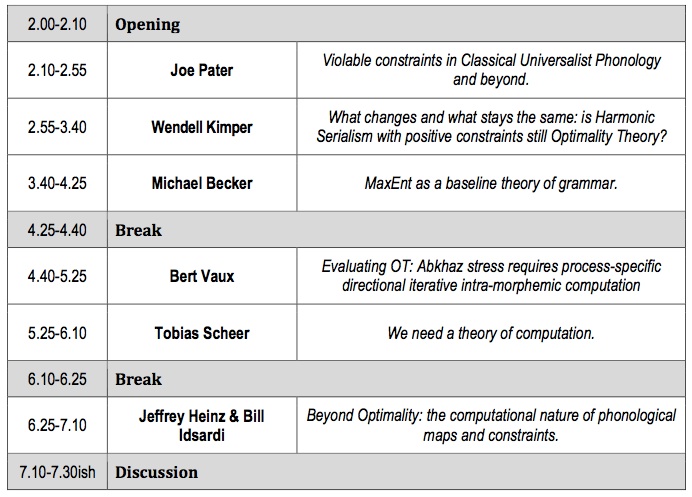Background
Given that there are
always lots of phonologists in Manchester the day before the Manchester
Phonology Meeting (the 'mfm') starts, we thought that we
could make use of this to hold a workshop on a topic in phonological
theory that we think is pressing. This workshop is intended to be a relatively informal venue for
discussion and is not part of the
mfm - it's just
taking advantage of the timing of the mfm to set up a workshop, and
everyone is welcome to
attend. The workshop has been organised by:
Topic
A storm of pointing fingers swept the
world in 1993 as Optimality Theory (OT) rapidly became the 'mainstream'
theory of phonological computations, a position it was to occupy for
many years thereafter. We now seem to have reached a stage where many
properties of OT as a formal theory are known: we have fairly well
worked-out models of how OT grammars can be acquired, and how they can
predict typologies. We also know that OT can be combined with a wide
variety of theories of phonological representations, and that much
depends on what would be a theory of possible constraints, although
there is no consensus on what such a theory would look like.
It is our impression, however, that interest in OT has been diminishing lately while no single alternative seems to be occupying its former position as the mainstream theory of phonological computations. Recent years have witnessed a great deal of work on constraint-based approaches to phonological computation belonging to the same broad family as OT: Harmonic Serialism, Harmonic Grammar, Serial Harmonic Grammar, etc. At the same time, much ongoing work on topics such as phonological representations, the interactions of phonology with other components of grammar, variation, and learning biases is no longer automatically framed in optimality-theoretic terms (or continues in frameworks unconnected to OT).
A part of the phonological community thus seems to be abandoning OT precisely at a time when its properties have become well understood, but the reasons for this decision and for its timing are not immediately apparent. In this fringe workshop, we want to take stock. Where are we with OT today? Which of the ideas in the framework continue to inspire research and are still important for the future? Which aspects of the theory have turned out to be so problematic that they really need repair? Is there still going to be OT in 20 years from now?
It is our impression, however, that interest in OT has been diminishing lately while no single alternative seems to be occupying its former position as the mainstream theory of phonological computations. Recent years have witnessed a great deal of work on constraint-based approaches to phonological computation belonging to the same broad family as OT: Harmonic Serialism, Harmonic Grammar, Serial Harmonic Grammar, etc. At the same time, much ongoing work on topics such as phonological representations, the interactions of phonology with other components of grammar, variation, and learning biases is no longer automatically framed in optimality-theoretic terms (or continues in frameworks unconnected to OT).
A part of the phonological community thus seems to be abandoning OT precisely at a time when its properties have become well understood, but the reasons for this decision and for its timing are not immediately apparent. In this fringe workshop, we want to take stock. Where are we with OT today? Which of the ideas in the framework continue to inspire research and are still important for the future? Which aspects of the theory have turned out to be so problematic that they really need repair? Is there still going to be OT in 20 years from now?
Speakers
The full version of the plan for the workshop, with abstracts from the speakers, is available here.The plan aims to incorporate time for contributions from the audience, and from two discussants: Ricardo Bermudez-Otero and Marc van Oostendorp. The discussants will get the first comment or question after each speaker.
The basic plan for the workshop is as follows:

Attending
It is free to attend the
workshop, and no registration is necessary - you can simply turn up on the day. The workshop will be held in a room at
the University of Manchester, which is close to Hulme Hall (where the
mfm will be held), but not quite in the same place - Hulme Hall is about
ten minutes' walk away.
This is where the workshop will be held:
This is where the workshop will be held:
- Arts Theatre, Samuel Alexander Building, University of Manchester: here on google maps
- you can find the Samuel Alexander Building on the University of Manchester's interactive maps page here
- it's relatively straightforward to walk to the university from
the city centre (it will take about 20 minutes), but the same set of
buses as described on the mfm travel page
will also get you to the Fringe meeting, but you'll need to get off the
bus earlier - the relevant bus stop for that is the one after the first
University stop, so you'll need to pass under a bridge, in front of the
"tin can" building (=first University stop), and get out just past the
second set of traffic lights after that; then cross the road onto the
"Lime Grove" walkway and walk into the classical-looking entrance of
the main building that you'll notice on the left - the Arts Theatre is
straight ahead and has two equally valid entrances, each down a few
steps on either side
